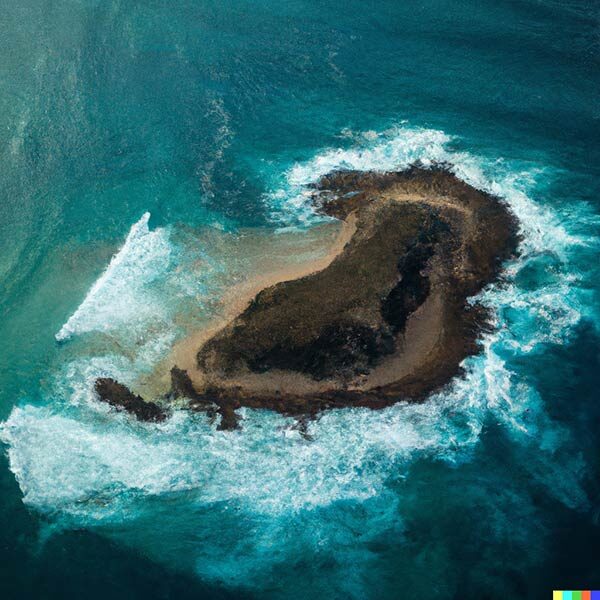Posted March 3, 2023 about
August 31-9/1, 2022
The Great Barrier Reef, approximately 1,400 miles long and shown as a dark area in the map above, lies off the east coast of Queensland, Australia.
Its south end (at Lady Elliot Island) sits about 50 miles off the mainland coast. From there, the reef gradually angles in towards the coast, as little as 6 miles away at its closest point.
Scattered between the Great Barrier Reef and the mainland Australian coast are hundreds of islands. Glancing at a map, one might assume these barrier-reef protected islands provide an easy, ideal cruising ground, but the map images don’t convey the whole story.
The Barrier Reef isn’t actually a solid object but is instead a structure made up of 3000 smaller reefs. At its south end, the reefs are more scattered, providing less protection to the islands in that area. Further north, the reefs become more densely packed, creating more of a protective barrier for the islands inside them.
Near the Barrier Reef’s north end, it’s easier to find swell-free anchorages. But no islands are immune to the wind waves created by the sometimes-strong trade winds in this area. These wind waves have an amazing ability to wrap around even sizeable islands.
But the wind waves aren’t the only issue to contend with as the tides are also an issue. In one area the tidal range goes as high as 28 feet! Near the Whitsunday Islands it’s more like 16 feet, not as extreme but still considerable. It’s easy to see that a reef that might offer protection at low tide could be much less helpful at high tide.
As if these things weren’t complicated enough, there’s another issue: the strong, fast currents these big tides create, especially when they go against the wind which creates nasty wave and sea conditions. Of course we’ve had past dealings with wind against current conditions, mostly when going through channels between land masses. What we didn’t fully grasp was the extremes that can happen in wide open areas. We’d eventually come to learn more about that the hard way.
At this point, early in this season’s Queensland coastal cruise, we knew that many anchorages could potentially be rolly, especially the smaller islands further away from the reef. We’d always have to take several factors–wind strength, wind direction, swell conditions outside (and inside) the reef, wind waves, and proximity to protective reefs and/or surrounding islands (which could be very handy at blocking swell)–into account when choosing a passage window and/or anchorage. Soon we’d be adding current to that list.
During our night in the anchorage behind Cape Capricorn, we did get some light roll, probably near peak high tide, but it gentled once again into a pleasant calm. I didn’t mind the movement at all and enjoyed hearing small wavelets breaking on shore during that time.
My standard for anchorage rolliness could be defined by what I call the wineglass principle.

Can I set a glass wineglass (with wine) down on a countertop and expect it to stay put? If the answer is yes, it’s a comfortable anchorage even if there’s some movement. If I have to use a plastic glass (the marine and campervan-type that’s short and stout), conditions may not be as serene but still tolerable as long as that glass stays secure. At the point the plastic glass falls over, well, things are not so good (especially if it was a full glass of wine!). In this case, I think a glass wineglass would have worked through the night.
Rich didn’t seem to mind the late-night movement, but in what turned out to be another harbinger of things to come: he did take notice of it and didn’t seem particularly pleased.
For now we had a nice night, waking up in the morning in no rush to leave. What a pleasure to be nestled in our chairs in the morning air, mildly cool so we were cozied up in sweatpants and pullovers, drinking our coffee, and noticing how much prettier this anchorage looked in the light of the morning sun.
Meanwhile, I had mentally put this place in the category of a stop along the road, not a destination anchorage, but suddenly Rich seemed concerned that Great Keppel Island might be a letdown if it were too much like this. I wasn’t worried in that no one talks about coming to this spot, but everyone gushes about Great Keppel, considered a Must-Do when cruising through the Great Barrier Reef islands.
Below is a map of Great Keppel Island. At first glance it looks like an island with a lot of appealing, beach-ringed anchorages. But in reality the bays on the east and south side of island are often untenable because of prevailing southeasterly winds. Even when the wind is northerly, there could still be some roll depending on the swell activity outside the reef.
On this map, I’ve added some lines, an amateur depiction indicating conditions we encountered during our coastal cruise. The green line shows the anchorages that would be too exposed in a south or eastly wind. I’ve added the pink line to show areas where the swell would wrap around and affect what might look like otherwise appealing anchorages. (Of course boats with a very shallow draft, that can tuck in close to shore, might not have to worry so much about wrap-around swell.)
Finally, I’ve added a small yellow line to show an area that we would have considered safe from swell while we were there that was, in fact, quite rolly during that time (as we later heard from friends who were anchored there).
Bottom line: It’s occasionally possible to visit the south and easterly bays on Great Keppel, but usually it’s the bays on the north or west side that are do-able. And even then, those anchorages can be affected by swell.
Below is an image (AI generated) of an extreme but not uncommon case of waves wrapping around an island…
–Cyndi







